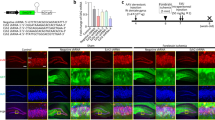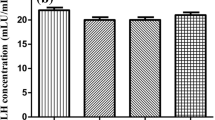Abstract
Tumor necrosis factor (TNF) participates in regulation of many processes, including carcinogenesis and apoptosis. However, at present, there are practically no studies on peculiarities of apoptosis control in tnf-knockout (tnf-/-) mice. These mice develop without morphologic abnormalities, but they seem to have impairment of many biological processes, such as inflammation, programmed cell death, etc. Therefore, the goal of our work was to study possible pathways of regulation of apoptosis in the absence of TNF in neurosecretory cells (NSC) of young and old mice. For this purpose, we determined immunohistochemically expression of apoptosis markers caspase-8, caspase-9, Bax, Bcl-2, Mcl-1, neuropeptide vasopressin and the apoptosis level in hypothalamus of tnf-knockout mice of different ages as compared with mice with unchanged level of TNF synthesis. It was shown that the apoptosis activation observed during aging did not depend on the tnf gene and that apoptosis at aging was caspase-dependent. It was revealed that at aging in mouse NSC the external cell death pathway with participation of caspase-8 is activated. The pathways mediating cell death in different neurosecretory centers at aging are different. Thus, in supraoptic nucleus (SON), in all studied animal groups, an important cause of the NSC apoptosis is Bax. In paraventricular nucleus (PVN), of the greater importance is a decrease of the anti-apoptotic protection. Hence, misbalance of synthesis of proteins of the Bcl-2 family plays an important role in development of senescent apoptosis.
Similar content being viewed by others
References
Bazhanova, E.D., Danilova, O.A., and Chernigovskaya, E.V., Response to Stress of Nonapeptidergic Hypothalamic Centers in Aged and Young Rats, Morfologiya, 1996, vol. 110,no. 5, pp. 30–33.
Bazhanova, E.D., Molodtsov, V.N., and Pavlov, K.I., Changes of Expression of Apoptosis-Associated Molecules in Neurosecretory Cells of Hypothalamus of Mice at Aging, Morfologiya, 2006, vol. 130, no. 6, pp. 35–39.
Bazhanova, E.D., Molodtsov, V.N., Popovich, V.N., and Anisimov, V.N., Regulation of Apoptosis of Neurosecretory Cells of Hypothalamus in Transgenic Mice HER2/neu in Ontogenesis, Usp. Gerontol., 2007, vol. 20, no. 3, pp. 31–35.
Molodtsov, V.N., Senchenkov, E.V., and Bazhanova, E.D., Apoptosis and Expression of Vasopressin, Insulin, and Bcl-2 in Neurosecretory System of Aged Mice, Zh. Evol. Biokhim. Fiziol., 2006, vol. 42, no. 3, pp. 283–288.
Brown, L., Ongusaha, P.P., Kim, H.G., Nuti, S., Mandinova, A., Lee, J.W., Khosravi-Far, R., Aaronson, S.A., and Lee, S.W., CDIP, a Novel Proapoptotic Gene, Regulates TNFalpha-Mediated Apoptosis in a p53-Dependent Manner, EMBO J., 2007, vol. 26, no. 14, pp. 3410–3422.
Fliers, E., Swaab, D.F., Pool, C.W., and Vewer, W.H., The Vasopressin and Oxytocin Neurons in the Human Supraoptic and Paraventricular Nucleus: Changes with Aging and in Senile Dementia, Brain Res., 1985, vol. 342, pp. 45–53.
Grivennikov, S.I., Tumanov, A.V., Liepinsh, D.J., Kruglov, A.A., Marakusha, B.I., Shakhov, A.N., Murakami, T., Drutskaya, L.N., Forster, I., Clausen, B.E., Tessarollo, L., Ryffel, B., Kuprash, D.V., and Nedospasov, S.A., Distinct and Nonredundant in vivo Functions of TNF Produced by t Cells and Macrophages/Neutrophils: Protective and Deleterious Effects, Immunity, 2005, vol. 22, pp. 93–104.
Hui, H., Fernando, M.A., and Heaney, A.P., The Alpha(1)-Adrenergic Receptor Antagonist Doxazosin Inhibits EGFR and NF-kappaB Signalling to Induce Breast Cancer Cell Apoptosis, Eur. J. Cancer, 2008, vol. 44, pp. 160–166.
Ishii, N., Role of Oxidative Stress from Mitochondria on Aging and Cancer, Cornea, 2007, vol. 26, no. 9, suppl. 1, pp. S3–S9.
Li, Y., Kong, L., Yang, Y., and Li, K., Mutant TNFalpha Negatively Regulates Human Breast Cancer Stem Cells from MCF7 in vitro, Cancer Biol. Ther., 2007, vol. 6, pp. 1480–1489.
Lim, H.H., De Lano, F.A., and Schmid-Schonbein, G.W., Life and Death Cell Labeling in the Microcirculation of the Spontaneously Hypertensive Rat, J. Vasc. Res., 2001, vol. 38, pp. 228–236.
Lucassen, P.J., Chung, W.C., Kamphorst, W., and Swaab, D.F., DNA Damage Distribution in the Human Brain as Shown by in situ End Labeling: Area-Specific Differences in Aging and Alzheimer Disease in the Absence of Apoptotic Morphology, J. Neuropathol. Exp. Neurol., 1997, vol. 56, pp. 887–900.
Madden, S.D., Donovan, M., and Cotter, T.G., Key Apoptosis Regulating Proteins Are Down-Regulated during Postnatal Tissue Development, Int. J. Dev. Biol., 2007, vol. 51, no. 5, pp. 415–423.
Marino, M.W., Dunn, A., Grail, D., Inglese, M., Noguchi, Y., Richards, E., Jungbluth, A., Wada, H., Moore, M., Williamson, B., Basu, S., and Old, L.J., Characterization of Tumor Necrosis Factor-Deficient Mice, Proc. Nat. Acad. Sci. USA Immunol., 1997, vol. 94, pp. 8093–8098.
Petersen, S.L., Wang, L., Yalcin-Chin, A., Li, L., Peyton, M., Minna, J., Harran, P., and Wang, X., Autocrine TNFalpha Signaling Renders Human Cancer Cells Susceptible to Smac-Mimetic-Induced Apoptosis, Cancer Cell, 2007, vol. 12, no. 5, pp. 445–456.
Stevenson, H.S., Fu, S.W., Pinzone, J.J., Rheey, J., Simmens, S.J., and Berg, P.E., BPI Transcriptional Activates bcl-2 and Inhibits TNFapha-Induced Cell Death in MCF7 Breast Cancer Cells, Breast Cancer Res., 2007, vol. 9, no. 5, p. R60.
Sternberger, L.A. and Joseph, S.A., The Unlabeled Antibody Method: Contrasting Color Staining of Paired Pituitary Hormones without Antibody Removal, J. Histochem. Cytochem., 1979, vol. 27, pp. 1424–1429.
Sun, M., Chen, M., Dawood, F., Zurawska, U., Li, J.Y., Parker, T., Kassiri, Z., Kirshenbaum, L.A., Arnold, M., Khokha, R., and Liu, P.P., Tumor Necrosis Factor-alpha Mediates Cardiac Remodeling and Ventricular Dysfunction after Pressure Overload State, Circulation, 2007, vol. 115, pp. 1398–1407.
Varfolomeev, E., Blankenship, J.W., Wayson, S.M., Fedorova, A.V., Kayagaki, N., Garg, P., Zobel, K., Dynek, J.N., Elliot, L.O., Walweber, H.J., Flygare, J.A., Fairbrother, W.J., Deshayes, K., Dixi, V.M., and Vucic, D., IAP Antagonists Induce Autoubiquitination of c-IAPs, NF-kappaB Activation and TNFalpha-Dependent Apoptosis, Cell, 2007, vol. 131, pp. 669–681.
Vince, J.E., Wong, W.W., Khan, N., Feltham, R., Chau, D., Ahmed, A.U., Benetatos, C.A., Chunduru, S.K., Condon, S.M., McKinlay, M., Brink, R., Leverkrus, M., Tergaonkar, V., Schneider, P., Callus, B.A., Koentgen, F., Vaux, D.L., and Silke, J., IAP Antagonists Target cIAP1 to Induce TNFalpha-Dependent Apoptosis, Cell, 2007, vol. 131, pp. 682–693.
Wu, H., Tschopp, J., and Lin, S.C., Smac Mimetics and TNFalpha: a Dangerous Liaison?, Cell, 2007, vol. 131, pp. 655–658.
Yang, P., Peairs, J.J., Tano, R., Zhang, N., Tyrell, J., and Jaffe, G.J., Caspase-8-Mediated Apoptosis in Human RPE Cells, Invest. Ophthalmol. Vis., 2007, vol. 48, pp. 3341–3349.
Zhang, L., Kokkonen, G., and Roth, G.S., Identification of Neuronal Programmed Cell Death in situ in the Striatum of Normal Adult Rat Brain and Its Relationship to Neuronal Death during Aging, Brain Res., 1995, vol. 677, no. 1, pp. 177–179.
Author information
Authors and Affiliations
Corresponding author
Additional information
Original Russian Text © E. D. Bazhanova, K. I. Pavlov, I. G. Popovich, V. N. Anisimov, 2009, published in Zhurnal Evolyutsionnoi Biokhimii i Fiziologii, 2009, Vol. 45, No. 5, pp. 518–523.
Rights and permissions
About this article
Cite this article
Bazhanova, E.D., Pavlov, K.I., Popovich, I.G. et al. Ontogenetic peculiarities of regulation of apoptosis of hypothalamic neurosecretory cells in TNF-knockout mice. J Evol Biochem Phys 45, 627–633 (2009). https://doi.org/10.1134/S0022093009050107
Received:
Published:
Issue Date:
DOI: https://doi.org/10.1134/S0022093009050107




